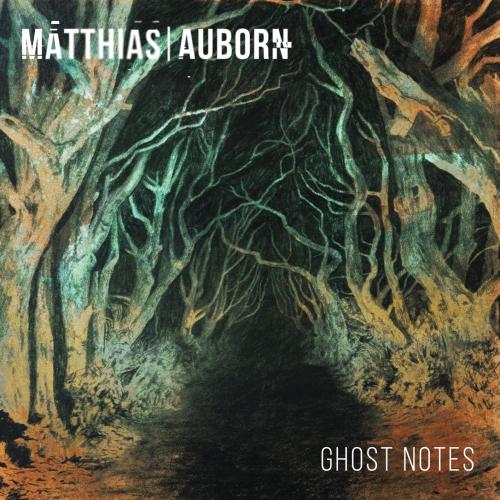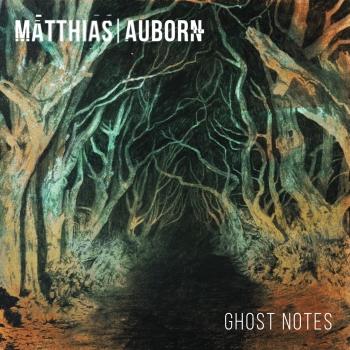
Ghost Notes John Matthias & Jay Auborn
Album info
Album-Release:
2023
HRA-Release:
07.04.2023
Album including Album cover
- Jay Auborn, John Matthias: Dive Into This:
- 1 Auborn, Matthias: Dive Into This 05:50
- Long Time Dead:
- 2 Auborn, Matthias: Long Time Dead 04:26
- Auto Psalm Engine:
- 3 Auborn, Matthias: Auto Psalm Engine 04:58
- Love Laced:
- 4 Auborn, Matthias: Love Laced 03:27
- No Parable:
- 5 Auborn, Matthias: No Parable 06:17
- Silver Solenoids:
- 6 Auborn, Matthias: Silver Solenoids 05:05
- Christmas at The Twisted Wheel:
- 7 Auborn, Matthias: Christmas at The Twisted Wheel 04:52
- Vodka & Coke:
- 8 Auborn, Matthias: Vodka & Coke 03:07
- Sum Over Histories:
- 9 Auborn, Matthias: Sum Over Histories 02:42
- Sweetness:
- 10 Auborn, Matthias: Sweetness 03:29
Info for Ghost Notes
John Matthias and Jay Auborn join forces again for a new album. Ghost Notes boldly explores human- robotic collaboration through mini electronic symphonies.
On Ghost Notes, John Matthias and Jay Auborn’s latest album, the British duo take their experiments with sound to new levels, catapulting their work into unexplored territories of human-robotic collaboration. Matthias and Auborn first partnered for the 2017 release “Race to Zero''. The album, and the soundtrack to the feature film, IN THE CLOUD and the soundtrack to BROADMEAD (Stanley Donwood and Mat Consume) which they have collaborated on since, makes evident the musicians’ mutual desire to push hard at the boundaries between physical and digital sound worlds – an exploration they had been pursuing individually for years. Between their shared passions and complementary skills, the musicians found a unique and undeniably bold synergy. Ghost Notes continues to be driven by this force; for the album, John Matthias and Jay Auborn gave their computer limbs and unleashed its agency, improvising alongside this new band member to create mini electronic symphonies.
The ghost in Ghost Notes refers to a robot drummer, although its appearance is less corporeal than it might sound. In fact, it employs quite crude technology not too different from your set of automatic car keys. John Matthias and Jay Auborn used solenoid magnets to convert audio signals sent from their computer into voltages that could fire hammers that would in turn hit a real drum kit. “It looks like a science experiment, all covered in wires”. Despite the rudimentary looks, ghost-drummer does an impressive job; allowing for digital collaboration with real instruments. In other words, instead of working with samples played off speakers, these can now be reproduced live, in a physical space.
As if straight out of a scene in Mary Shelley’s novel Frankenstein, the first time John Matthias and Jay Auborn brought their creation to life was a haunting experience. They fed it complex rhythmic information from a 1950s jazz recording of drum solos and lo and behold the drum kit came alive in the room with shocking resemblance to the original performance. That chilling encounter which, in the musician's eyes took technological appropriation to new, terrifying levels, pivoted the musician’s ideas: “We realised that we could use the method to extract the low level often overlooked rhythmic patterns within our own recorded or live material. [...] We now focused on creating Ghostly echoes of our own performances rather than invoking the dead to be in our band”.
This process became the bare bones behind the composition of Ghost Notes, rather than playing acoustic instruments and later digitally manipulating these recordings, these two stages were brought together in one moment and place in time, “The digital elements of our music were in the room with us during the improvisational stage, and in binding them together, we could create a live album of sorts”.
Just like a live session is filled with and shaped by factors such as the energy emanating from the audience on any given night, or the acoustics of a particular venue, Ghost Notes also embraces and plays on the undetermined. As the computer struggled under the demands of interpreting John Matthias and Jay Auborn’s improvisations live, it would sometimes act unexpectedly, hitting the drums as if possessed by its own agency. “Errors in the digital processing became fruitful diversions, like John Cage’s Ghost in the machine”. The result of this cyborgian jam session? A high-energy album featuring a wide range of sounds and tempos. In this regard, Ghost Notes stands in stark contrast to the more minimal, ambient output of other artists experimenting with similar frameworks of digital-acoustic interplay. Perhaps it’s because of this immersive quality, where textures, layers and emotional dramaturgy all combine to create unheard of worlds and make it impossible for partial listening, that Ghost Notes’ first track is named ‘Dive Into This’. Matthias' soaring violin lures listeners into shifting landscapes of syncopated drum beats and cycling synths. Classical structures are deconstructed into electronica and back, all the while Auborn is distorting acoustic sounds beyond recognition. “It’s about screwing with the materiality of it,” he says.
Although Ghost Notes is rich, layered and textured, it’s not one inch impenetrable. What could otherwise feel dense gets pierced by enthralling melodies such as virtuosic violin segments that pull on 19th-century romanticism, or soulful piano grooves à la Alice Coltrane or Marvin Gaye. At other times, the music tells imaginative stories, “In Christmas at the Twisted Wheel, we created a mini violin concerto which begins in an imagined Christmas advert for John Lewis through a dissonant landscape to The Twisted Wheel Northern Soul Club in Manchester”.
Ghost Notes is a testament to the enormous artistic freedom John Matthias and Jay Auborn have achieved together. Within the conceptual framework they set for themselves, they trusted sound to be their one and only guide, a model which led the duo on a vast exploration between extremes and nuances, like the collision and subtleties laid out on ‘Vodka and Coke’. In the track, emotional violin comes together with raw, brutal textures - “caveman beats” as the duo calls them. White-washed static noises are heard as the track progresses, the result of the computer’s own interpretations of what it was being fed, creating a surprising unison between the two contrasting worlds. “The sounds were a kind of digital shadow of ourselves. An in-betweenness of acoustic and digital”. It’s in that in-betweenness which doesn't sit comfortably in either classical nor electronica that Ghost Notes succeeds. It’s within that grey space between humans programming robots, and robots breaking down and erring like humans that the album achieves its finest, most original aesthetic expression, opening a new path for human-robotic collaboration in music-making.
John Matthias, violin, electronics
Jay Auborn, various instruments, electronics
John Matthias
is a musician, composer and academic who has released albums via Accidental, Ninja Tune, Nonclassical, Village Green and collaborated with artists including Radiohead and Coldcut. In 2008 he won the UK PRS Foundation New Music Award (The 'Turner Prize' for music) with Jane Grant and Nick Ryan for the development of a huge sonic installation entitled 'The Fragmented Orchestra’. He is Associate Professor in Sonic Arts at Plymouth University.
Jay Auborn
is a producer and musician based in south west England - an art school dropout that fell in love with the sampler. Much of his previous work is self-released under aliases exploring the boundaries between sound art and music. ‘Race to Zero’ marks his debut for Village Green, and the continuation of a creative partnership with John Matthias. Jay currently manages a recording studio for dBs Music.
The duo recently soundtracked a film about Bristol’s Broadmead shopping centre by Stanley Donwood and Mat Consume and co-wrote additional music for the film ‘Poor Boy’ directed by Robert Scott Wildes which was premiered at the Tribeca Film Festival in New York 2016.
This album contains no booklet.










